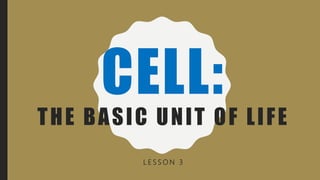Q2 l3-basic unit of life
•Download as PPTX, PDF•
0 likes•34 views
educational purposes
Report
Share
Report
Share

Recommended
Recommended
More Related Content
Similar to Q2 l3-basic unit of life
Similar to Q2 l3-basic unit of life (20)
More from Heart Break Institution
More from Heart Break Institution (20)
Recently uploaded
Recently uploaded (20)
Measures of Central Tendency: Mean, Median and Mode

Measures of Central Tendency: Mean, Median and Mode
Ecological Succession. ( ECOSYSTEM, B. Pharmacy, 1st Year, Sem-II, Environmen...

Ecological Succession. ( ECOSYSTEM, B. Pharmacy, 1st Year, Sem-II, Environmen...
Z Score,T Score, Percential Rank and Box Plot Graph

Z Score,T Score, Percential Rank and Box Plot Graph
Unit-IV; Professional Sales Representative (PSR).pptx

Unit-IV; Professional Sales Representative (PSR).pptx
Web & Social Media Analytics Previous Year Question Paper.pdf

Web & Social Media Analytics Previous Year Question Paper.pdf
Basic Civil Engineering first year Notes- Chapter 4 Building.pptx

Basic Civil Engineering first year Notes- Chapter 4 Building.pptx
Micro-Scholarship, What it is, How can it help me.pdf

Micro-Scholarship, What it is, How can it help me.pdf
ICT Role in 21st Century Education & its Challenges.pptx

ICT Role in 21st Century Education & its Challenges.pptx
On National Teacher Day, meet the 2024-25 Kenan Fellows

On National Teacher Day, meet the 2024-25 Kenan Fellows
Seal of Good Local Governance (SGLG) 2024Final.pptx

Seal of Good Local Governance (SGLG) 2024Final.pptx
Q2 l3-basic unit of life
- 1. CELL: THE BASIC UNIT OF LIFE L E S S O N 3
- 2. HOW BIG IS A CELL? http://www.cellsali ve.com/howbig.ht m
- 3. 3 BASIC STRUCTURE OF A CELL
- 4. 4 HISTORY OF CELLS & THE CELL THEORY Virchow Cell Specialization
- 5. 5 FIRST TO VIEW CELLS • In 1665, Robert Hooke used a microscope to examine a thin slice of cork (dead plant cells) • What he saw looked like small boxes
- 6. 6 FIRST TO VIEW CELLS •Hooke is responsible for naming cells •Hooke called them “CELLS” because they looked like the small rooms that monks lived in called Cells
- 7. 7 ANTON VAN LEEUWENHOEK • In 1673, Leeuwenhoek (a Dutch microscope maker), was first to view organism (living things) • Leeuwenhoek used a simple, handheld microscope to view pond water & scrapings from his teeth
- 8. 8 BEGINNING OF THE CELL THEORY •In 1838, a German botanist named Matthias Schleiden concluded that all plants were made of cells •Schleiden is a cofounder of the cell theory
- 9. 9 BEGINNING OF THE CELL THEORY •In 1839, a German zoologist named Theodore Schwann concluded that all animals were made of cells •Schwann also cofounded the cell theory
- 10. 10 BEGINNING OF THE CELL THEORY • In 1855, a German medical doctor named Rudolph Virchow observed, under the microscope, cells dividing • He reasoned that all cells come from other pre- existing cells by cell division
- 11. 11 CELL THEORY • All living things are made of cells • Cells are the basic unit of structure and function in an organism (basic unit of life) • Cells come from the reproduction of existing cells (cell division)
- 14. 14 PROKARYOTES – THE FIRST CELLS • Cells that lack a nucleus or membrane- bound organelles • Includes bacteria • Simplest type of cell • Single, circular chromosome
- 15. 15 PROKARYOTES • Nucleoid region (center) contains the DNA • Surrounded by cell membrane & cell wall (peptidoglycan) • Contain ribosomes (no membrane) in their cytoplasm to make proteins
- 16. 16 EUKARYOTES • Cells that HAVE a nucleus and membrane-bound organelles • Includes protists, fungi, plants, and animals • More complex type of cells
- 17. 17 EUKARYOTIC CELL Contain 3 basic cell structures: •Nucleus •Cell Membrane •Cytoplasm with organelles
- 18. 18 TWO MAIN TYPES OF EUKARYOTIC CELLS Plant Cell Animal Cell
